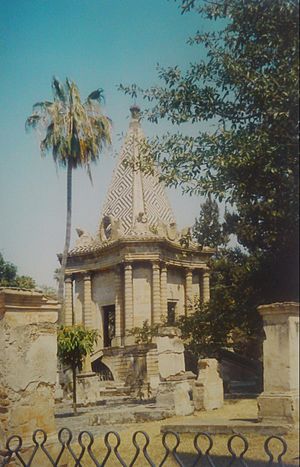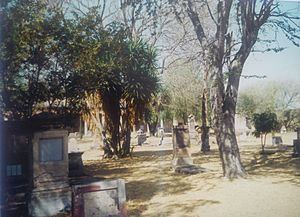Panteón de Belén facts for kids
The Panteón de Belén is a very old and famous cemetery in Guadalajara, Mexico. It's also known as the Santa Paula Cemetery. This historic place is well-known for its many spooky legends and special night tours! It first opened its gates in 1848 but stopped being used for new burials in 1896. Even though it's no longer an active burial ground, you can still visit it today for both daytime and evening tours.
History
For many years, the Panteón de Belén was the resting place for important historical figures from Jalisco. Later, their memorials were moved to a new place called the Rotonda de los Jaliscienses Ilustres. The cemetery's first name was Santa Paula Cemetery. It was part of a big project started by a kind friar named Antonio Alcalde.
Why a New Cemetery?
Long ago, Guadalajara faced many serious epidemics (widespread diseases). The hospitals at the time were too small to help all the sick people. In 1737, the Spanish king asked for information about the hospitals. Later, in 1751, the king gave permission to build a new, bigger hospital. King Ferdinand VI even sent money and plans for the new building.
In 1786, Guadalajara suffered a terrible famine, which meant there wasn't enough food. This time was known as the "Year of Hunger." The old hospital was still too small to care for everyone who became sick. So, on May 3, 1793, a new and much larger hospital, called the Hospital of Belén, was finally opened.
After Mexico's War of Independence, Guadalajara faced more tough times. There were more famines and diseases, like a terrible cholera outbreak in 1833. Cholera was a very dangerous illness that caused many people to die. Because of this, Guadalajara needed a new cemetery. This new cemetery had to be built outside the main city areas. The land used for the hospital's gardens was chosen for the cemetery. That's why it became known as the "Panteón de Belén" (Belén Cemetery), named after the hospital.
Building the Cemetery
The Panteón de Belén was built in 1848. An architect named Manuel Gómez Ibarra designed it. He was asked to do this by Bishop Diego de Arana y Carpinteiro.
Special Areas
The Panteón de Belén was originally split into two main parts. One area was for ordinary people. The other section was set aside for very wealthy families.
The cemetery was called Santa Paula Cemetery because the chapel in the middle of the wealthy section was dedicated to Saint Paula. Underneath this chapel was a special tomb, called a mausoleum. This mausoleum held the remains of the city's most important people. However, in 1957, all these remains were moved to a new place called the Rotonda de los Jaliscienses Ilustres.
Today, the common burial area of the cemetery is gone. It was replaced by a building for the hospital, which is now called the "Old" Civilian Hospital. This hospital is owned by the University of Guadalajara. But the wealthy part of the cemetery was reopened to the public. Many exciting and sometimes scary legends were created to make it a popular place to visit, almost like a "museum of the macabre" (meaning a museum about death and spooky things).
Spooky Legends
The Panteón de Belén is famous for its many legends! You might hear stories about: The Vampire, The Pirate, The Lovers, The Monk, The Child afraid of the Dark, The Story of José Cuervo, The Nun, and many more. These tales are now a big part of the local folklore.
People have reported seeing ghosts there, but some think it might just be their imagination. Still, Mexican culture has a strong interest in the dead, especially around Day of the Dead (November 2). This draws many people to both the daytime and nighttime tours of the cemetery.
Fen-om is a group that shares facts about Mexican culture. They often include the Panteón de Belén in their tours of Guadalajara. Many of the traditional stories from the graveyard are part of their tours, which happen seven days a week.
See also
 In Spanish: Panteón de Belén para niños
In Spanish: Panteón de Belén para niños



